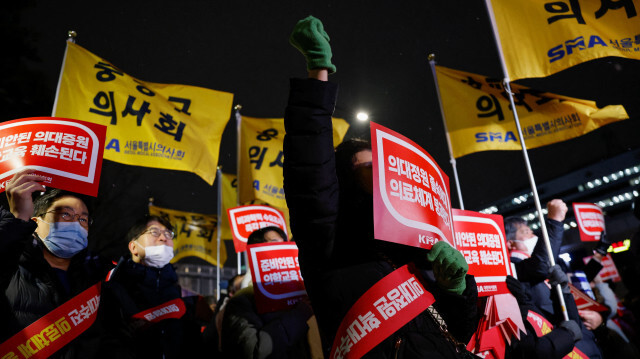

File photo
Junior doctors have been protesting since February against a government plan to increase the medical school admission quota
Over eight months ago, thousands of junior doctors in South Korea walked off their jobs in protest against a new government plan to increase the number of doctors in the country.
The movement launched in February has now led to one of the longest-ever medical strikes in the world and triggered a healthcare crisis in the country of over 52 million people.
The core issue is the government's plan to add 2,000 more students to the current quota of 3,058 in next year's medical school admission.
Over 14,000 junior doctors launched the protests and more than 6,400 submitted their resignations on Feb. 20. The Health Ministry issued a warning the very same day, ordering the protesters to return to their duties or face disciplinary measures.
The warning, followed by another in July, had little impact, as there are still some 7,700 trainee doctors who have resigned and remain on strike.
President Yoon Suk Yeol's government aims to add around 10,000 more doctors to the health system by 2035, part of measures to address its low doctor-to-patient ratio of 2.1 physicians per 1,000 people.
Yoon warned last year that the healthcare system was collapsing, stressing the need for urgent steps to prepare for the transition to a super-aged society.
South Korea has a rapidly aging population and is expected to have the largest share of people aged 65 years or older in the world by 2044, according to official estimates.
That makes healthcare reforms and increasing medical personnel numbers a critical priority, but doctors insist the government must first improve their existing working conditions.
- No end in sight to health crisis
The shortage of staff at medical facilities in South Korea has reached a point where, according to a recent survey, several major hospitals are considering shutting down for good.
That poll found a total of 535 doctors serving at 53 major training hospitals across the nation, a drop of 40% from last year's 914.
The South Korean military has opened emergency departments at its hospitals to the public, while the Health Ministry deployed military doctors and public physicians to hospital emergency rooms last month.
Other stopgap steps include nurses being given authority to take on more medical roles under legal protection, but the situation remains challenging.
The government and ruling People Power Party (PPP) proposed forming a consultative body to lead negotiations, but that was rejected by the protesters, who insisted that the government first withdraw its plan of increasing the medical school admission quota.
“If the government wants dialogue, it should halt the probe into the mass resignations of trainee doctors and stop pushing for the quota hike plan for 2025,” Choi An-na, a spokesperson for the Korean Medical Association, said in mid-September.
The South Korean presidential office followed up with another appeal a few weeks ago, calling on the medical community to come forward for dialogue and offering to readjust the admission quota for 2026.
“The medical community should not put off resolving the issue by presenting preconditions to the proposal on the consultative body, including a change in the government's stance,” Jang Sang-yoon, a senior presidential secretary, was quoted as saying by Yonhap News Agency.
He asserted that the government “remains flexible” on changes for 2026 and later, as well as open to discussing “scientifically grounded and reasonable proposals brought forward by the medical community.”
#doctors strike
#junior doctors
#Medical strike
#South Korea
